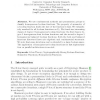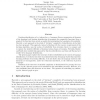1507 search results - page 15 / 302 » Separating Complexity Classes Using Structural Properties |
ACISP
1999
Springer
14 years 2 months ago
1999
Springer
We use combinatorial methods and permutation groups to classify homogeneous boolean functions. The property of symmetry of a boolean function limits the size of the function’s cl...
EUROCOLT
1995
Springer
14 years 1 months ago
1995
Springer
Limiting identification of r.e. indexes for r.e. languages (from a presentation of elements of the language) and limiting identification of programs for computable functions (fr...
BMCBI
2010
13 years 10 months ago
2010
Background: MHC/HLA class II molecules are important components of the immune system and play a critical role in processes such as phagocytosis. Understanding peptide recognition ...
IPPS
2000
IEEE
14 years 2 months ago
2000
IEEE
This paper is on the Consensus problem, in the context of asynchronous distributed systems made of n processes, at most f of them may crash. A family of failure detector classes s...
CSE
2009
IEEE
14 years 1 months ago
2009
IEEE
An important aspect in social computing is the structure of social networks, which build the underlying substrate for the exchange of information. With the growing importance of mi...


